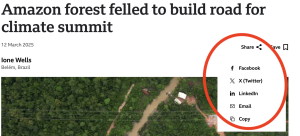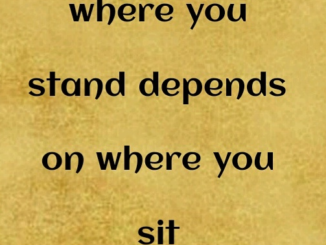
Introduction
This study looks at how digital-native news sources differ from conventional online news companies. To do so, this analysis compares the web journalism techniques employed by the BBC and Jalopnik in their stories on the building of a road for the climate summit in the Amazon.
Biography
The British Broadcasting Company (BBC) was founded on 18 October 1922, starting its daily broadcasts from Marconi’s London studio, 2LO, located in the Strand, on November 14, 1922 (1920s, n.d.).

The BBC is designed to operate independently, and runs under a Royal Charter and Framework Agreement, outlining the BBC’s constitution, journalistic independence, and public duties (Seaton, 2021).
Later on BBC News Online was launched in November 1997, a platform providing access to news from the BBC, available to audiences anywhere (bbc.co.uk Is Launched, n.d.).
BBC’s operations are mostly funded by the license fees paid by UK families, a method set by the government. The second most present revenue comes from commercials (BBC Group & Secretary of State for Culture, Media and Sport, 2024).
Audience
The BBC’s latest Global Audience Measurement (GAM) for 2024 reports an impressive weekly audience of 450 million, slightly up from 447 million in 2023. Part of the readers is an international audience of 320 million viewers across 42 language services.
According to the BBC’s annual report 2023/24, in the UK 95% of adults access its services monthly and 75% weekly for news, reaffirming its status as the country’s top news source. The BBC has been the leading news source in the United Kingdom from 2018 to 2024 (Statista, 2024).
Jalopnik
Biography
Jalopnik is a news and opinion website launched in 2005, and currently owned by Static Media as of 2024 (Jalopnik, 2025).

Originally, created under Gawker Media, Jalopnik established its identity by highlighting automobiles, technology, and all things automotive. The news website is committed to operating with transparency and independence (Policies – Jalopnik, 2020).
The vast majority of revenue that Static Media generates is from programmatic advertising through respected ad platforms such as Google (Policies – Jalopnik, 2020).
Unlike traditional news outlets, Jalopnik emphasizes opinion pieces that engage and provoke their audience (Tbaxt, 2017).
Audience
Jalopnik is made to appeal to a diverse group of automotive enthusiasts, from industry professionals to casual fans.
Their content is mainly about cars, the automotive industry, racing, transportation, airplanes, and technology, but also news about current affairs or the environment (Jalopnik, 2025).
This audience is not just looking for data but for stories and perspectives that challenge mainstream automotive journalism (Tbaxt, 2017).
An analysis reveals that the audience is mainly from the United States, being 77.27% male and 22.73% female and that the largest age group of visitors is 45 – 54 year-olds.
Engagement and scannability
The BBC article is structured with short paragraphs on average with two sentences. This enhances readability as users can scan through the content quickly.
By maintaining balance with a short headline, short sentences, and paragraphs, the news story can perform better online due to mobile usage and limited user attention spans (Bradshaw, 2023).

The BBC’s headline captures attention, employing keywords such as “Amazon” and “Climate Summit.” These enhance searchability and immediately convey the subject matter to the reader; it is straightforward, and optimized for search engines.
Despite including scannable properties the BBC fails to incorporate sub-headings which are highly important as 79% of web users scan pages, using the F-shaped pattern (Nielsen, 1997, as cited in Bradshaw, 2023). They look for headlines, subheadings, and links, to help them navigate the text on the screen (Bradshaw, 2023).
In comparison, Jalopnik, unlike the BBC, includes sub-headings, as seen in the illustration below, providing the reader with numerous entry points into the text (Bradshaw, 2023).

Jalopnik’s article, maintains a user-friendly layout with a balance between text and images, keeping the reader’s attention without overwhelming them.
The length of paragraphs could be discussed as some have a length of 4-5 sentences as shown below. It is recommended to make a point in one or two sentences at most and then move on to the next paragraph (Bradshaw, 2023).

Enhancing brevity can enhance engagement and the overall effectiveness of the story. Comparatively, it is a practice that the BBC tends to execute perfectly.
Writing Styles & composition
In the BBC’s article, the writing style is formal with the use of precise and structured language, exemplified by the words highlighted in yellow in the illustration below.
This reflects the BBC’s high standards as “Audiences expect the BBC to demonstrate the highest standards of English” (BBC News Style Guide, n.d.).

The inverted pyramid technique is used by the BBC, reinforcing credibility: starting with a lead sentence using the 5W’s approach (Who, What, When, Where, Why), then adding detailed support and various perspectives, and closing with future implications.
This technique ensures that even readers with limited time can grasp the most critical information (Po¨Ttker, 2003).
Comparatively, the use of language is different between Jalopnik’s article and the BBC’s. Jalopnik’s story is more critical and less formal. As illustrated below it uses sarcasm such as “How very environmentally-minded of them.”

This practice might influence the reader’s perception of credibility; usually, it is recommended when writing a news story about current events to be direct, neutral, and impartial (Jaakkola, 2018).
However, journalism is an ever-changing practice, and the tone of voice used might appeal to a certain public. Hardy et al. (2014), cited by Kulkarni et al. (2022), suggest that such comic forms of narratives can be more effective than traditional news delivery.
The inverted pyramid technique is also implemented in Jalopnik’s article, however, the lead sentence could be optimized, compared to the BBC’s.
It relies on the traditional 5 W’s but suffers from being too lengthy, and a repetition, diminishing the impact: “Amazon/rainforest is being cleared”, as shown below.
Multimedia usage
Jalopnik’s article illustrates a constraint in the use of multimodality, using only three images that lack relevance and captions, weakening the connection to the article’s subject, and leaving readers unclear about the content’s context.
“Captions are detrimental as they indicate how the visual material links to the text narrative” (E. Lapere, personal communication, March 18, 2025).
Jalopnik’s feature image is not impactful, reducing scannability, as a strong illustration at the top of a story matters to grab the attention of the reader (Bradshaw, 2023).
Using an image of a vibrant, intact Amazon does not reflect the story’s focus on deforestation and road construction, potentially misleading readers about the true environmental impact.
In comparison, The BBC uses a mix of six different media types, including drone footage of deforestation, photos of affected areas and people, and a map for geographic context; making the coverage more engaging and informative.
The BBC effectively uses captions for all media, enhancing the storytelling’s impact and credibility. Practice that Jalopnik fails to engage in as mentioned above.
The lead media compared to Jalopnik’s is impactful and strong, as it showcases “Drone shots show the scale of Amazon deforestation for COP30 road”, also enhancing scannability.
“The integration of text, images, audio, and video enhances the sensory experience of news consumption as a multimodal approach facilitates deeper engagement and understanding” (Teshabaeva, 2024).
Jalopnik’s minimalistic approach compared to the BBC’s, therefore, might not only affect the depth of user engagement but also the credibility and overall communicative efficacy of the article.
Interactive features & navigation
The BBC’s story includes accessible sharing options on platforms like Facebook, Twitter, LinkedIn, and email. This not only extends the article’s reach but also facilitates reader interaction with the content.

Beneath the story, readers are encouraged to engage further by signing up for the “Future Earth Newsletter.” However, there is no space for comments or other types of interactions, this suggests a more redactional interactivity.

In comparison, Jalopnik does not provide sharing options but allows for comments, providing a space for viewpoints; this creates a more dynamic content consumption compared to the BBC’s.
Jalopnik also provides the option to contact journalists directly, adding transparency and building trust, indicating a more dialogic form of interactivity compared to the BBC.
Laslty, the use of hyperlinks is not present in the BBC’s story, this reduces interactivity and credibility.
“Hyperlinks are a defining characteristic of online journalism” (Bradshaw, 2023).
In comparison, Jalopnik’s news story showcases hyperlinks, all with working links opening in a different tab, this enhances interactivity and accuracy.
Conclusion
Traditional BBC delivery is formal and structured, with significant multimedia to add credibility and depth. It could be improved by adding more interactive features to engage audiences. Jalopnik adopts a digital-native model with a more casual tone and emphasis on engagement, although it uses less multimedia and has less depth and precision than the BBC. Jalopnik may appeal to a more casual audience, but the BBC is stronger and more credible.
Word count: 1514
References
1920s. (n.d.). BBC. https://www.bbc.com/historyofthebbc/timelines/1920s
BBC Annual Report: Delivering for audiences and transforming for the future. (n.d.). https://www.bbc.co.uk/mediacentre/2024/annual-report-delivering-for-audiences-and-transforming-for-the future#:~:text=The%20report%20shows%20that%20the,and%20to%20bring%20people%20together.
BBC News style guide. (n.d.). https://www.bbc.co.uk/newsstyleguide/
bbc.co.uk is launched. (n.d.). BBC. https://www.bbc.com/historyofthebbc/anniversaries/december/bbc-website-launched#:~:text=There%20were%20initial%20problems%20that,BBC%20website%20was%20officially%20launched.&text=Online%20milestones%20quickly%20followed%3A%20that,online%20for%20the%20first%20time
BBC Group & Secretary of State for Culture, Media and Sport. (2024). BBC Group Annual Report and Accounts 2023/24[Report]. https://www.bbc.co.uk/aboutthebbc/documents/ara-2023-24.pdf#page=57
Bradshaw, P. (2023). Writing for the web. In Routledge eBooks (pp. 76–105). https://doi.org/10.4324/9780429321566-4
Jaakkola, M. (2018). Journalistic writing and style. Oxford Research Encyclopedia of Communication. https://doi.org/10.1093/acrefore/9780190228613.013.884
Jalopnik. (2025). About us – Jalopnik. https://www.jalopnik.com/about/
Kulkarni, S., Thomas, R., Komorowski, M., & Lewis, J. (2022). Innovating Online Journalism: New Ways of Storytelling. Journalism Practice, 17(9), 1845–1863. https://doi.org/10.1080/17512786.2021.2020675
Policies – Jalopnik. (2020, December 9). Jalopnik. https://www.jalopnik.com/policies/
Po¨Ttker, H. (2003). News and its communicative quality: the inverted pyramid—when and why did it appear? Journalism Studies, 4(4), 501–511. https://doi.org/10.1080/1461670032000136596
Seaton, J. (2021). The BBC: Guardian of public understanding. Guardians of Public Value: How Public Organisations Become and Remain Institutions, 87-110. https://doi.org/10.1007/978-3-030-51701-4
Statista. (2024, September 13). Most used news sources in the UK 2018-2024. https://www.statista.com/statistics/266709/leading-news-sources-in-the-uk/
Tbaxt. (2017, March 10). A brief analysis of Jalopnik. Rhetoric of Digital Publishing. https://rhetofdigitalpublishing.wordpress.com/2017/03/10/a-brief-analysis-of-jalopnik/
Teshabaeva Dilfuza. (2024). Multimodality in internet news media. Open Herald: Periodical of Methodical Research, 2(1), 1–3. Retrieved from https://academiaone.org/index.php/6/article/view/484

















Be the first to comment